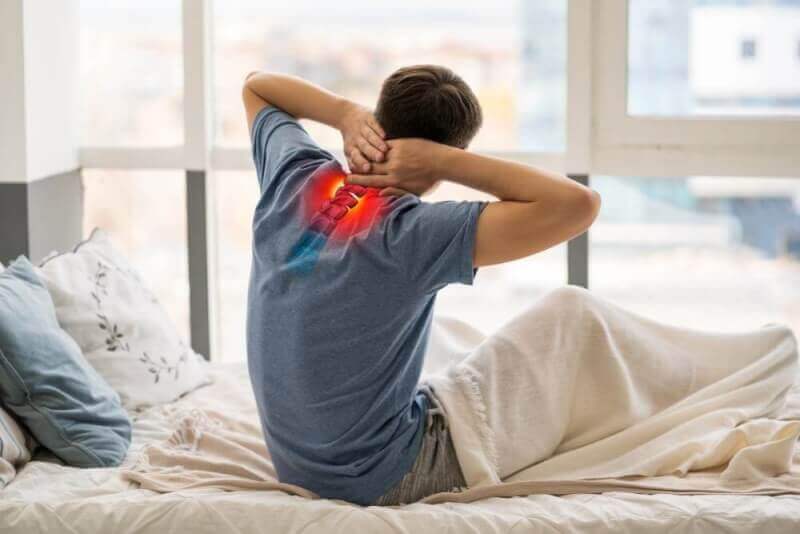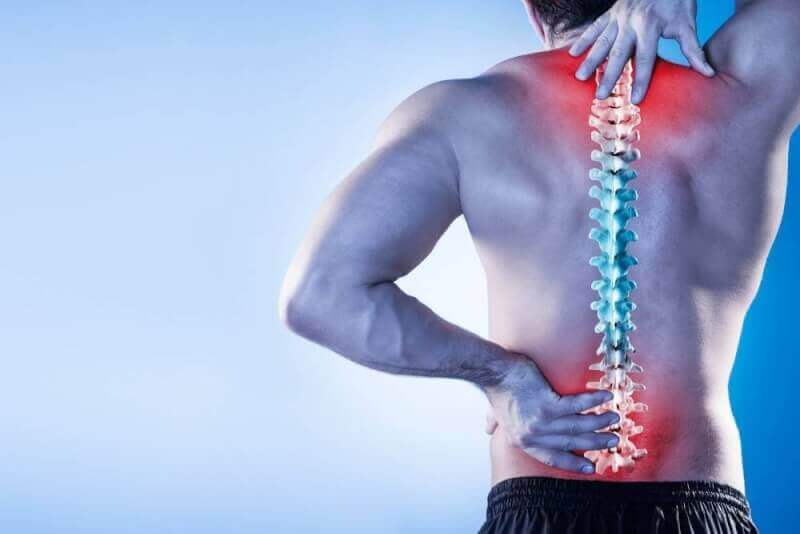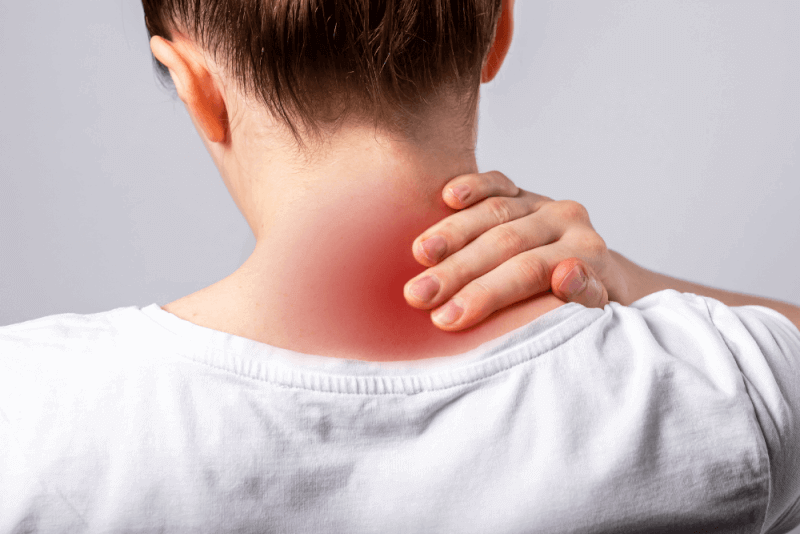30-Second Summary
- If you spend long hours in front of the computer, at a desk, without engaging in physical activities, or if your muscles are genetically weaker than average, you are in the risk group for cervical disc herniation.
- Despite the neck not carrying much weight, its mobile structure makes it susceptible to degeneration and an increased risk of disc herniation.
- Cervical disc herniation, which affects the spinal cord and nerve roots, is among the chronic conditions observed in individuals in their 30s and 40s.
- In some individuals, cervical disc herniation occurs due to structural characteristics. It is observed more frequently in people with thin, delicate, and long necks compared to those with shorter necks, as their muscle structure is generally weaker.
If you spend long hours in front of the computer, at a desk, without engaging in physical activities, or if your muscles are genetically weaker than average, you are in the risk group for cervical disc herniation. Cervical disc herniation, which can develop from prolonged computer work and inactivity, continues to negatively impact the quality of life for many people. However, the newly developed methods in neurosurgery today significantly shorten diagnosis and treatment processes, leading to an improvement in quality of life.
What is Cervical Disc Herniation?
The spine in our body is one of the most important parts of our skeletal system, providing resistance against vertically acting body weight and external forces, as well as enabling movement functions. Therefore, it must possess two contrasting characteristics: mobility and stability. These two features are achieved through the segmented structure of the spine and the discs located between the vertebrae. Discs absorb forces applied during vertical rotation and lateral bending. Standing on two feet also increases the forces exerted on the discs. As a result, the discs between the vertebrae gradually deteriorate with age and start to wear out over time. Their load-bearing capacity and durability decrease, which can lead to herniation.
Despite the neck not carrying much weight, its mobile structure makes it susceptible to degeneration and a high risk of disc herniation. Each vertebra in the neck region extends from the respective vertebrae to the back and arms, providing sensation and movement to these areas. Cervical disc herniation occurs when the gelatinous inner part of the disc tissue between the vertebrae ruptures the outer layer made of stronger connective tissue, exerting pressure on the spinal cord and nerves.
Types of Cervical Disc Herniation
Cervical Disc Herniation is classified into two stages: acute and chronic.
Acute Stage
In cases where the nucleus pulposus is freely expelled or herniated, acute cervical disc herniation is observed with unilateral pain radiating to the shoulder blade and chest, extending to the upper extremities. This pain is also noted to increase during activities such as straining, coughing, and sneezing.
Chronic Stage
In the chronic stage, a condition called cervical spondylosis occurs, often due to the formation of osteophytes (bone spurs) or widespread degeneration of the structures forming the spinal system. If pain and numbness become more frequent and bed rest is not taken within a certain period, a consultation with a neurosurgeon is essential, and all symptoms should be reported to the doctor without omission.
Symptoms of Cervical Disc Herniation
Cervical disc herniation, which affects the spinal cord and nerve roots, is among the chronic conditions observed in individuals in their 30s and 40s. Symptoms of cervical disc herniation vary depending on the location of the herniation, the signs of the condition, its duration, and severity, and may differ from person to person. The most common symptoms of cervical disc herniation observed today are as follows:
- Pain that radiates down to the fingertips, accompanied by numbness
- Pain radiating to one side of the body, particularly in the arm
- Difficulty walking and imbalance
- Weakness in the affected arm along with pain and numbness
- Dropping objects held in hand
Symptoms of Cervical Disc Herniation Rupture
In case of cervical disc herniation rupture, certain symptoms may be observed in the affected area. These symptoms include:
- Numbness
- Tingling
These symptoms start on the side of the herniation and later spread to the shoulders and arms.
Symptoms of Cervical Disc Herniation Based on Nerve Root
There are seven vertebrae in the neck. The discs where herniation occurs influence the symptoms observed. According to this, the symptoms observed in patients include:
- If herniation is seen between C4 and C5, pain and tingling can spread to the shoulder. Weakness may be felt in the deltoid muscle and other muscles.
- If herniation occurs between C5 and C6, pain and tingling or numbness may be felt around the thumb side of the hand. In addition, weakness can be experienced in the biceps and extensor muscles of the forearm. This is one of the most common discs where herniation occurs.
- If herniation is seen between C6 and C7, pain, tingling, and numbness may be observed in the middle finger of the hand. Weakness may also be observed in the triceps, finger extensors, and other muscles. This is the most common disc interval where herniation is seen.
- If herniation occurs between C7 and T1, pain, tingling, and numbness can be felt on the outer part of the forearm and the little finger. It causes weakness in the grip of the fingers and other muscles.
Causes of Cervical Disc Herniation
Cervical disc herniation occurs for various reasons. Compared to the lumbar region, the neck has a more delicate structure. Therefore, it has been observed that deformations in the neck start at an earlier age. Prolonged sitting at a desk, continuously looking at the same point, holding the neck in the same position for extended periods, spending long hours in front of the television or tablet, exposure to cold air conditioning for short or long durations, and lack of daily exercise are among the causes of cervical disc herniation.
In some individuals, cervical disc herniation also occurs due to structural characteristics. It is often observed more in people with thin, delicate, and long necks compared to those with short necks, as their muscle structures are generally weaker. Furthermore, these individuals are more susceptible to environmental factors and lifestyle compared to others. If poor neck posture is also an issue, they carry a higher risk of cervical disc herniation. In contrast, individuals with short necks and broad skulls have a nearly negligible risk of cervical disc herniation.
People who smoke also have a significantly higher risk of cervical disc herniation. Especially those who start smoking at a young age experience more rapid degeneration in the neck. While smoking generally leads to lung cancer within about 20 years, cervical disc herniation cases can be observed within the first 5 years in smokers. Moreover, genetic factors play a major role in cervical disc herniation. If there are cases of cervical disc herniation in one's family, the likelihood of that individual experiencing cervical disc herniation is much higher.Inappropriate working and sleeping postures also play a significant role in laying the groundwork for cervical disc herniation. Especially falling asleep while sitting is known as an important factor in cervical disc herniation.
Risk Factors for Cervical Disc Herniation
- Incorrect movement and posture of the neck
- Experiencing trauma, car accidents, working in professions such as banking, or driving
- Spending long hours in front of a computer
- Weakness in the neck muscles
- Fatigue, poor posture, and psychological stress
- Housework, sewing, hanging curtains, cleaning windows, and other similar activities increase neck pain. Therefore, neck pain is observed more frequently in women than men.
- Incorrectly performed massage
How is Cervical Disc Herniation Diagnosed?
A detailed medical history and physical examination are crucial in diagnosing cervical disc herniation. In many cases, diagnosis can be made based solely on these two factors. However, it is also extremely important to confirm the presence of cervical disc herniation through imaging techniques. For a definitive diagnosis, a detailed neurological examination and appropriate radiological studies are required.
Treatment of Cervical Disc Herniation
If the observed condition is mild, rest, a stress-free lifestyle, painkillers, and physical therapy can help slow down the disease and provide treatment. However, if neck and severe arm pain persist despite medication and physical therapy, and continue to negatively affect the patient, surgical treatment may be necessary.
Today, cervical disc herniation surgeries achieve far better results compared to the past. The micro-surgical method provides a solution to the pain and significantly improves the quality of life, which is often affected by the discomfort caused by cervical disc herniation.
The goal of cervical disc herniation surgery is to relieve the pressure on the spinal cord and nerves, while preserving many anatomical structures and the neck’s ability to bear weight and move adequately. Depending on the nature and progression of the herniation, the patient can regain their health shortly after surgery.
Types of Cervical Disc Herniation Surgery
There are several different surgical methods used in the treatment of cervical disc herniation. However, due to its effectiveness in removing pathology and preventing future neural compression, cervical discectomy is considered the gold standard. Additionally, posterior laminoforaminotomy is the most suitable option for patients with anterolateral herniation. Total disc replacement remains a topic of debate in the medical field.
Various techniques are applied in cervical disc herniation surgeries. If the surgery is performed from the front, the disc must first be removed to reach the herniated tissue. During surgery, it is possible to remove the disc and clean any calcifications if present. In some cases, a replacement disc may or may not be placed. A technique called PEEK CAGE is used to allow the two bones to fuse quickly. Additionally, prosthetics may be used to prevent loss of mobility post-surgery.
Anterior Cervical Microdiscectomy Surgery
This surgery is performed with a microscope. After entering from the front of the neck, the herniated disc part is removed, but no supportive material is placed. Patients need to wear a neck brace for an extended period to allow the remaining discs to fuse. Since no supportive material is placed, this method is rarely preferred due to the prolonged recovery time.
Anterior Cervical Discectomy and Fusion Surgery
This is the most commonly performed technique in cervical disc herniation surgeries. Surgeons also use a microscope in this method. The procedure involves entering from the front of the neck and removing the herniated disc part. Subsequently, a fusion and a cage called PEEK CAGE, made from polyether ketone materials, is placed to stabilize the spine and ensure faster fusion between the vertebrae. PEEK CAGE not only facilitates faster and stronger fusion but also serves as a space for placing bone grafts.
Anterior Cervical Discectomy and Cervical Disc Prosthesis Surgery
This is another operation involving an anterior approach and the use of a microscope. After removing the herniated disc, an artificial joint, called a cervical disc, which mimics the joint function, is placed instead of a cage to allow the adjacent discs to fuse. This method aims to prevent movement restriction after surgery.
Endoscopic Cervical Disc Herniation Surgery
The pinnacle of cervical disc herniation surgeries is the endoscopic method. This surgery is performed through an incision just a few millimeters wide, using a fine surgical instrument.
This method, which can be done from both the front and back, is preferred because it helps preserve surrounding healthy tissues and reduces the risk of infection. Since an artificial joint is placed between the vertebrae during surgery, patients do not experience restricted movement after the procedure.
Risks of Cervical Disc Herniation Surgery
The risks associated with cervical disc herniation surgery vary depending on the type of procedure and anesthesia used. However, the common risks observed in patients include:
- Difficulty swallowing
- Bleeding
- Spinal cord and nerve damage
- Hoarseness
- Cerebrospinal fluid leakage
- Skin infection
- Respiratory failure
- Esophageal injury
- Infection in disc joints
- Horner's syndrome
- Issues related to prosthetics
Neck Immobilization
Patients with cervical disc herniation may be advised to wear a neck brace to relax neck muscles and reduce pain. Wearing a neck brace for about a week is generally recommended to control acute pain.
Traction
Traction is a treatment option that can help reduce radicular symptoms associated with cervical disc herniation. Theoretically, the pulling force applied during traction is thought to relieve pressure on the nerves, providing comfort.
Medication Therapy
There is no evidence supporting the effectiveness of NSAIDs in cervical disc herniation, yet these drugs are often prescribed to patients. Thus, their effects on patients can be proven within a short period.
Another group of drugs prescribed for cervical disc herniation includes COX-1 and COX-2 inhibitors, which have analgesic effects. The COX-2 group has lower gastrointestinal toxicity. In cases of severe pain, steroidal anti-inflammatory drugs may be prescribed for short-term use.
In cases of muscle spasms, muscle relaxants may be prescribed, and in cases of neuropathic pain, antidepressants can be used.
Cervical Disc Herniation Pillow
In general, no weight should be placed on the spine during sleep. For patients with cervical disc herniation, this becomes even more crucial. Therefore, choosing the right pillow is extremely important for patients with cervical disc herniation.
With a properly selected cervical disc herniation pillow, patients can maintain the natural curve of the spine while lying on their backs. For those who sleep on their sides, these pillows help keep the spine straight and prevent any weight from pressing on it.
When selecting the right cervical disc herniation pillow, attention should first be paid to the material. Memory foam pillows and fiber blends offer excellent flexibility. Additionally, the pillow should be chosen at a height that helps keep the neck aligned.
Neck Hernia Exercises
Neck hernia exercises, which are one of the treatment options for cervical disc herniation, should be determined by physical therapy specialists and taught to patients. The exercises prescribed for cervical disc herniation help relieve the neck and reduce patients' symptoms. The recommended exercises for cervical disc herniation are generally divided into two main groups.
Isometric Neck Hernia Exercises
Isometric neck hernia exercises include four basic movements. The first of these is called flexion resistance. The steps for this exercise are as follows:
- This exercise should be performed standing.
- While standing, patients place their hands on their foreheads.
- Then, while pushing the head forward, the hands apply opposite force.
- The head resists the force applied by the hands.
- Count to 5 or 10 while performing the movement, then take a short break before repeating.
Another movement in isometric neck exercises is extension resistance. The steps to perform this exercise are as follows:
- The extension resistance movement is essentially the opposite of the flexion resistance exercise. Therefore, while standing, patients place their hands behind their heads.
- Then, as the head is pushed backward, the hands apply force in the opposite direction.
- Applying pressure for 5 or 10 seconds is sufficient. It is recommended that patients take a short break before repeating the movement.
The third exercise in isometric exercises is resistance to lateral bending. The steps to perform this exercise are as follows:
- Lateral bending resistance is also performed while standing. Therefore, patients should be in a ready position while standing.
- Then, patients place their hands on the sides of their heads.
- The head is then gently turned in one direction.
- The hand on the side of the head being turned resists this movement. The head is alternately turned to the right and left.
- Counting to 5 or 10 while applying force is sufficient.
- It is recommended that patients rest for a few seconds before repeating the movement.
The final exercise in isometric exercises is resistance to rotation. The steps to perform this exercise are as follows:
- This exercise should also be performed while standing.
- To perform this movement, first, place the right hand behind the head and the left hand on the temple area.
- Then, while trying to look to the left, apply opposite force with the left hand.
- In the next step, switch hand positions and try to turn the head to the right.
Isotonic Neck Hernia Exercises
Isotonic neck hernia exercises consist of three consecutive steps, which are as follows:
- First, the head is slowly turned to the right and held for 3 seconds. Then, the head is slowly turned to the left and held again for 3 seconds. Repeating this movement 5-10 times is sufficient.
- In the second step, the head is bent forward until the chin touches the chest. After holding this position for 3 seconds, the head is returned to its normal position. Repeating this movement 5 times is sufficient. To relax the neck muscles, the head is then tilted backward. The most important point in this movement is to avoid straining the neck muscles to ensure the chin reaches the chest area comfortably.
- In the final isotonic movement, the head is tilted to the right. Then the head is tilted to the left. Hold each side for 3 seconds. Repeating this movement 5-10 times is sufficient.
Precautions for Individuals with Cervical Disc Herniation
Patients diagnosed with cervical disc herniation should pay attention to the following in their daily lives:
- Patients should sit upright when seated at a desk or using a computer.
- They should avoid staying in the same position for too long. Therefore, patients who need to work at a computer for extended periods should take a break and move every 30 minutes.
- Stand upright while walking.
- While walking, the head should not be tilted forward, and no additional load should be placed on the neck.
- Do not tilt the head forward while using a phone.
- Regular exercise is recommended. Swimming and walking are especially recommended for individuals with cervical disc herniation.
- Patients should avoid sports that strain the neck.
Pain Caused by Cervical Disc Herniation
The pain caused by cervical disc herniation and its location can include the following:
- The pain caused by cervical disc herniation is not limited to the neck area.
- Pain from cervical disc herniation can also be felt in the shoulders, arms, chest area, and back.
- Additionally, cervical disc herniation may lead to headaches. Headaches can spread to the ears, causing ear pain in some patients.
- In some cases, patients may also feel pain in their legs due to cervical disc herniation.
- Besides pain, cervical disc herniation can also cause numbness and loss of sensation in the arms and legs.









